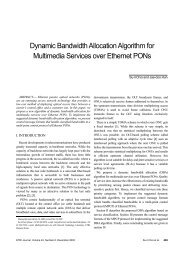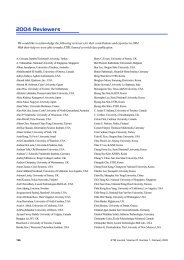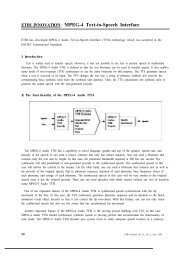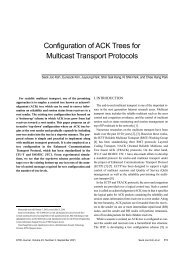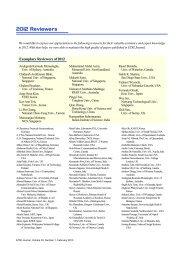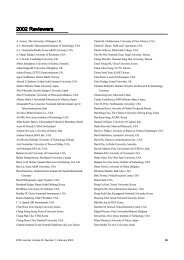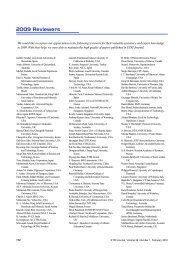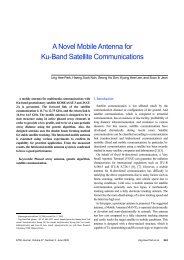Test-Generation-Based Fault Detection in Analog ... - ETRI Journal
Test-Generation-Based Fault Detection in Analog ... - ETRI Journal
Test-Generation-Based Fault Detection in Analog ... - ETRI Journal
Create successful ePaper yourself
Turn your PDF publications into a flip-book with our unique Google optimized e-Paper software.
circuit.Permanent faults are further classified <strong>in</strong>to catastrophic faults(open and short) and parametric faults (due to disturbance <strong>in</strong>the process parameters). When a catastrophic fault occurs, thetopology of the circuit is changed. Due to parametric faults, theperformance parameters of each manufactured circuit deviatefrom the nom<strong>in</strong>al one and therefore correspond to a differentpo<strong>in</strong>t <strong>in</strong> each parameter space. If each parameter of the circuitis with<strong>in</strong> a fault free space, then the circuit is treated as faultfree; otherwise, it is considered a faulty circuit.In this paper, catastrophic and parametric faults are taken asfault models for analog circuits, which are designed withresistors, capacitors, MOSFETs, and bipolar junctiontransistors. The test<strong>in</strong>g issues related to these faults areaddressed <strong>in</strong> this study.III. <strong>Test</strong> Pattern <strong>Generation</strong>S<strong>in</strong>ce the cost of test<strong>in</strong>g a VLSI chip is a significant fractionof the manufactur<strong>in</strong>g cost, the time required to test a chipshould be m<strong>in</strong>imized, and there should be significant faultcoverage. The objective of the automatic test pattern generatoris to f<strong>in</strong>d an optimal set of test stimuli which detects allmodeled faults, that is, a set of test stimuli which when appliedto the circuit can dist<strong>in</strong>guish between the correct circuit and anycircuit with a modeled fault.The goal of the proposed approach is to compute a set of teststimuli that maximizes the fault coverage while m<strong>in</strong>imiz<strong>in</strong>gtest access. Therefore, the problem of test signal generation isan optimization problem <strong>in</strong> pr<strong>in</strong>ciple. <strong>Test</strong> vector generationus<strong>in</strong>g determ<strong>in</strong>istic techniques is highly complex and timeconsum<strong>in</strong>g because of the extremely large search spaces<strong>in</strong>volved. Therefore, artificial <strong>in</strong>telligence methods have ga<strong>in</strong>edmuch attention [1], [2].Genetic algorithms are search optimization algorithms basedon the mechanics of natural genetics that attempt to use similarmethods for selection and reproduction to solve variousoptimization problems. Genetic algorithms have proven to beeffective <strong>in</strong> VLSI applications, <strong>in</strong>clud<strong>in</strong>g circuit layout andpartition<strong>in</strong>g, cell placement, rout<strong>in</strong>g, and automatic testgeneration. The proposed method uses a genetic algorithm forthe generation of the test stimulus which detects bothcatastrophic and parametric faults present <strong>in</strong> the circuit undertest (CUT).In the literature, a genetic algorithm is used as a test patterngenerator [1], [2] to generate a piece-wise l<strong>in</strong>ear (PWL)stimulus. In [1] and [2], multiple node po<strong>in</strong>ts <strong>in</strong> the circuits areconsidered for detect<strong>in</strong>g faults <strong>in</strong> the CUT. However, <strong>in</strong>complex systems all nodes <strong>in</strong> the circuit may not be accessible.Therefore, <strong>in</strong> this work only the output node is considered formeasurements and the output response is analyzed us<strong>in</strong>gwavelets.1. PWL Signal <strong>Generation</strong>By excit<strong>in</strong>g the CUT with pulses and ramps whosefrequency spectrum stretches over a wide range of frequencies,all faults can be made visible <strong>in</strong> the measurement space. Thus,a transient PWL signal is generated for detection of bothcatastrophic and parametric faults present <strong>in</strong> the circuits. Togenerate the PWL test signal, a genetic algorithm is used. Each testvector is a transient stimulus.Figure 1 shows an example test vector. The amplitude limitfor each test vector is fixed based on the allowable range of<strong>in</strong>put signal for the circuit, and the frequency of the stimulus isfixed based on the allowable operat<strong>in</strong>g frequency of the circuits.For example, if a circuit has a supply voltage of 2.5 V, a ga<strong>in</strong> of2, and a 1 MHz bandwidth, then the amplitude range for thePWL stimulus is fixed from -1 to +1 and the frequency is fixedfrom 1 Hz to 1 MHz. The length of the PWL signal is fixedbased on the amplitude level and frequency of operation of theCUT. Initial random vectors (PWL test signals) are selectedsuch that all amplitude levels are covered.Amplitude1.51.00.50.0-0.5-1.0-1.52. Bounds for Parameters1 2 3 4 5 6 7 8TimeFig. 1. PWL test vector.For the given CUT, the bounds of the parameters are foundas follows.In general, a circuit is bounded by n specifications, S =[s 1 , s 2 ,∙∙∙, s n ]. For design<strong>in</strong>g the circuit, m parameters, P =[p 1 , p 2 ,∙∙∙, p m ] are used. Each specification is dependent on oneor more parameters. Under s<strong>in</strong>gle parametric (p i ) faultassumption, upper and lower bounds of the parameters arefixed for each specification. Given an acceptable range of s j(upper bound s j u , lower bound s j l ), the accepted tolerance rangeof p i (upper bound p iu, lower bound p i l ) can be found as shown<strong>in</strong> Fig. 2.The f<strong>in</strong>al upper and lower bounds of the accepted range forp i are found as follows:p u i = m<strong>in</strong> (p u i1 , p u i2 ,∙∙∙, p u <strong>in</strong> ), (1)p l i = max (p l i1 , p l i2 ,∙∙∙, p l <strong>in</strong> ). (2)210 Palanisamy Kalpana et al. <strong>ETRI</strong> <strong>Journal</strong>, Volume 31, Number 2, April 2009




